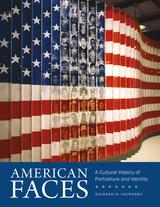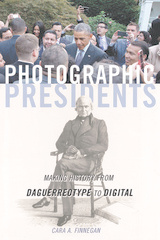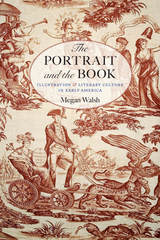3 books about Portraits, American

American Faces
A Cultural History of Portraiture and Identity
Richard H. Saunders
University Press of New England, 2016
Portraits. We know what they are, but why do we make them? Americans have been celebrating themselves in portraits since the arrival of the first itinerant portrait painters to the colonies. They created images to commemorate loved ones, glorify the famous, establish our national myths, and honor our shared heroes. Whether painting in oil, carving in stone, casting in bronze, capturing on film, or calculating in binary code, we spend considerable time creating, contemplating, and collecting our likenesses. In this sumptuously illustrated book, Richard H. Saunders explores our collective understanding of portraiture, its history in America, how it shapes our individual and national identity, and why we make portraits—whether for propaganda and public influence or for personal and private appreciation. American Faces is a rich and fascinating view of ourselves.
[more]

Photographic Presidents
Making History from Daguerreotype to Digital
Cara A. Finnegan
University of Illinois Press, 2021
Defining the Chief Executive via flash powder and selfie sticks
Lincoln’s somber portraits. Lyndon Johnson’s swearing in. George W. Bush’s reaction to learning about the 9/11 attacks. Photography plays an indelible role in how we remember and define American presidents. Throughout history, presidents have actively participated in all aspects of photography, not only by sitting for photos but by taking and consuming them. Cara A. Finnegan ventures from a newly-discovered daguerreotype of John Quincy Adams to Barack Obama’s selfies to tell the stories of how presidents have participated in the medium’s transformative moments. As she shows, technological developments not only changed photography, but introduced new visual values that influence how we judge an image. At the same time, presidential photographs—as representations of leaders who symbolized the nation—sparked public debate on these values and their implications.
Lincoln’s somber portraits. Lyndon Johnson’s swearing in. George W. Bush’s reaction to learning about the 9/11 attacks. Photography plays an indelible role in how we remember and define American presidents. Throughout history, presidents have actively participated in all aspects of photography, not only by sitting for photos but by taking and consuming them. Cara A. Finnegan ventures from a newly-discovered daguerreotype of John Quincy Adams to Barack Obama’s selfies to tell the stories of how presidents have participated in the medium’s transformative moments. As she shows, technological developments not only changed photography, but introduced new visual values that influence how we judge an image. At the same time, presidential photographs—as representations of leaders who symbolized the nation—sparked public debate on these values and their implications.
An original journey through political history, Photographic Presidents reveals the intertwined evolution of an American institution and a medium that continues to define it.
[more]

The Portrait and the Book
Illustration and Literary Culture in Early America
Megan Walsh
University of Iowa Press, 2017
In the nineteenth century, new image-making methods like steel engraving and lithography caused a surge in the publication of illustrated books in the United States. Yet even before the widespread use of these technologies, Americans had already established the illustrated book format as central to the nation’s literary culture. In The Portrait and the Book, Megan Walsh argues that colonial-era author portraits, such as Benjamin Franklin’s and Phillis Wheatley’s frontispieces; political portraits that circulated during the debates over the Constitution, such as those of the Founders by Charles Willson Peale; and portraits of beloved fictional characters in the 1790s, such as those of Samuel Richardson’s heroine Pamela, shaped readers’ conceptions of American literature.
Illustrations played a key role in American literary culture despite the fact there was little demand for books by American writers. Indeed, most of the illustrated books bought, sold, and shared by Americans were either imported British works or reprinted versions of those imported editions. As a result, in addition to embellishing books, illustrations provided readers with crucial information about the country’s status as a former colony.
Through an examination of readers’ portrait-collecting habits, writers’ employment of ekphrasis, printers’ efforts to secure American-made illustrations for periodicals, and engravers’ reproductions of British book illustrations, Walsh uncovers in late eighteenth-century America a dynamic but forgotten visual culture that was inextricably tied to the printing industry and to the early US literary imagination.
Illustrations played a key role in American literary culture despite the fact there was little demand for books by American writers. Indeed, most of the illustrated books bought, sold, and shared by Americans were either imported British works or reprinted versions of those imported editions. As a result, in addition to embellishing books, illustrations provided readers with crucial information about the country’s status as a former colony.
Through an examination of readers’ portrait-collecting habits, writers’ employment of ekphrasis, printers’ efforts to secure American-made illustrations for periodicals, and engravers’ reproductions of British book illustrations, Walsh uncovers in late eighteenth-century America a dynamic but forgotten visual culture that was inextricably tied to the printing industry and to the early US literary imagination.
[more]
READERS
Browse our collection.
PUBLISHERS
See BiblioVault's publisher services.
STUDENT SERVICES
Files for college accessibility offices.
UChicago Accessibility Resources
home | accessibility | search | about | contact us
BiblioVault ® 2001 - 2024
The University of Chicago Press









